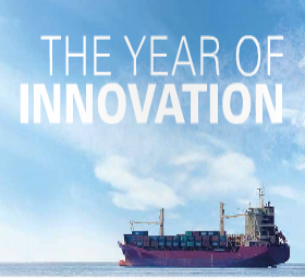2015 was a year of turmoil and uncertainty for the maritime industry. However out of stormy seas came strong technology trends and innovations that will make an immense impact on shaping the industry in 2016.
The quest to save fuel was once the great and mighty catalyst for technological innovation in the industry. When oil prices slumped in late 2013 and continued to decrease thereafter the focus of the technology innovators quickly shifted to developing solutions that support ship owner and operator efforts to future proof ships in order to remain commercially sustainable.
Of course, fuel saving didn’t slip completely out of the innovator’s sights but in recent years the industry has certainly witnessed the fruition of a few certain technology trends are increasing in market dominance while regulatory compliance and streamline operations. Smart Ships Although the industry’s journey towards greater digitalisation has already begun, the power of digital innovation is going to immensely shape the future.
A product of connectivity, big data and advanced connected analytical powers, the smart ship is being billed as the next ‘revolution’ for all sectors of the maritime industry. For global satellite communications provider Inmarsat, ‘Smart Connectivity’ is THE next ‘revolution’ in the global maritime industry, and they have put their money where their mouth is by investing heavily into launching four Global Xpress satellites that will give the industry access to seamless global connectivity. It is this kind of connectivity will power the smart ship and considerable innovation.
Talk of the ‘autonomous ship’ was endemic in 2015. In 2016, it can be predicted that the tremendous occupation of media headlines will remain as stakeholders pushing to make the world’s first autonomous cargo ship a reality fuel autonomous innovation through various projects and technology developments. This year, Rolls-Royce will sit at the helm of a EUR 6.6million research project to develop technologies to support autonomous shipping alongside several other industry heavyweights. This is a project to keep an eye on as it will certainly to provoke seeds of innovation in 2016.
During a recent Innovation Day hosted by DNV GL, several ship owners shared their experiences with digital innovation and shared insight on how is has advanced their business. Lasse Kristoffersen, Klaveness CEO identified a fundamental and exponential change in the level of connectivity, computing power and amount of data being generated every day. He told participents at the Innovation Day that Klaveness are investing 1–2% of revenues into digital. Investment in digital applications will continue to grow as the industry switching onto the smart ship concept, that is for certain.
NOx Abatement Technology
January 1, 2016 marked the enforcement of the International Maritime Organization’s (IMO) Nitrogen Oxides (NOx) Tier III standards. These standards stipulate that ships built on or after 1 January, 2016 that will operate within NOx Emission Control Areas (ECAs) must have reduced NOx emissions in correspondence with MARPOL Annex VI Regulation 13, which enforces an 80% NOx emissions reduction compared to Tier I levels.
Also, the United States (US) Environmental Protection Agency’s (EPA) Clean Air Act began enforcing “Tier 4”, for diesel engines built after January 1, 2016. A double dose of regulation for ship owners sailing is US waters. Although the IMO’s NOx Tier III regulation is only applicable to newbuilds and those ships with a power output of more than 130kW irrespective of tonnage, all ship owners and operators looking into expanding fleets sailing in NOx ECAs will now need to consider investing in technologies that will ensure compliance.
These include Selective Catalytic Reduction (SCR), Exhaust Gas Recirculation (EGR) and Liquefied Natural Gas (LNG) fuel. To date, more than 500 marine SCR systems have been installed. However, this double dose of regulation and the threatof further NOx controls emerging in other ECAs will drive a wave of innovation across both SCR and EGR technologies, similar to the rapid evolution of scrubber systems when manufacturers were forced to adapt their systems to needs of ship owners and their ship requirements.
DNV GL’s recent “Shipping 2020” report forecasted that at least 30– 40 % of newbuildings will be fitted with EGR or SCR systems by 2016 to meet emission requirements. The Classification Society stated in the report that the 80 % reduction requirements enforced by Tier III in NOx ECAs is undoubtedly the main motivator.
Ballast Water Management Systems
The International Maritime Organization (IMO) confirmed at the start of 2016 that the tonnage requirements for the Ballast Water Management Convention to enter into force had not been reached following a spate of ratifications in late 2015. Forty-seven countries have now ratified the convention, substantially more than the 30 required, but their combined fleets comprise, at most, 34.56% of global tonnage, with 35% required for entry into force.
The ratification of the current IMO Ballast Water Management Convention will bring in new regulations requiring all ships over 400 gt to install approved systems. The convention means that some 40,000 ships will need to be retrofitted with ballast water management system and newbuild ships will need to hit the water with a system pre-installed. It seems likely that the Convention could be ratified by more Member States imminently, which could surmount to the required tonnage triggering the Convention deployment during 2016 and subsequently enter into force in 2017.
This will be analogous to opening the flood gates for ship owners investing in ballast water treatment systems. The suggestion that owners and operators might be best to equip themselves with the Step-By-Strep Guide to Ballast Water Management, published by BIMCO and Fathom Maritime Intelligence would be a wise one.
Visit: http://bit.ly/1LCchyN
This feature was originally published in Issue 08.2016 of SHIP EFFICIENCY REVIEW magazine. Access that Issue here: http://bit.ly/1L3jo4q


































